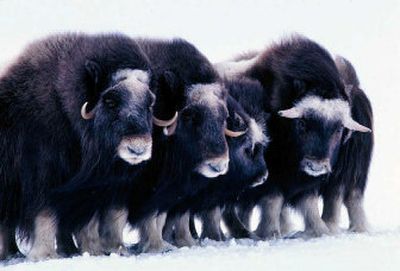Musk oxen decline on North Slope

Musk oxen, the shaggy ice age relics that once vanished from Alaska, are dying in big numbers on the North Slope.
They’re starving on remote barrier islands, drowning in floods and being devoured by grizzly bears, according to wildlife managers who recently banned musk ox hunting in the region to preserve the North Slope population.
Most of the losses have been in the Arctic National Wildlife Refuge, where there were 399 of the curvy-horned beasts in 1986. There was just one musk ox there this spring. Biologists say it may be dead.
“It’s just a mystery,” said Dick Shideler, a state Fish and Game biologist in Fairbanks. “We’re trying to put different pieces together and figure out why all of a sudden this is happening.”
Built for cold weather and lean times, the stocky animals wandered Alaska for thousands of years but disappeared in the mid-1800s, some say because of hunters. The federal government brought them back in 1931, shipping about three dozen from Greenland to Fairbanks.
Five years later, the animals were barged to Nunivak Island off the Yukon-Kuskokwim Delta coast, where they thrive today. Some of those musk oxen were transplanted to Western and Northern Alaska to start four other herds beginning in 1969.
That’s when the first of 64 Nunivak musk oxen were transplanted to ANWR. The herd flourished there for years. A few hundred moved to an area west of ANWR around Prudhoe Bay. Like the musk oxen that stayed in ANWR, their numbers are dropping fast too, from 302 to 216 in three years.
Puzzled state and federal scientists say herds elsewhere in the state are healthy. They’re scrambling to figure out why the numbers are falling on the Slope and say disease or poor nutrition may be factors.
The state and federal managers have shut down four different hunts in the last three years, mostly affecting villagers in Nuiqsut and Kaktovik, said Geoff Carroll, Barrow-area state biologist.
Hunting hasn’t played a big role in the decline, biologists said, with only a dozen or so musk oxen taken a year. But herd numbers are below limits allowed for hunting.
The closed hunting seasons are a shame, he said, because the meat was becoming a valued part of some subsistence diets. Inupiat initially resented the herd out of fear it would run off prized caribou, Carroll said. That never happened, he said.
One big factor in the decline: multiple kills by grizzlies. They seem to happen only on the North Slope, not to musk oxen in other herds, biologists say.
Musk oxen top out at 800 pounds and can kill smaller bears with thrusts from their dangerous horns. But on 14 occasions since 1998, a grizzly has killed two to six musk oxen at a time, biologists said.
A grizzly killed three on the frozen Beaufort Sea northeast of Prudhoe Bay in early May, said Roy Minatra, a security guard at the Endicott oil field.
Driving along the causeway that connects the man-made Endicott island to land, he said, he saw the grizzly race after a group of musk oxen. It swatted a calf to the ground, said Minatra, who watched through binoculars from about 1,000 yards away.
The bruin ate the calf for about 20 minutes, then chased down a calf and cow about half a mile away, he said. The second kills took a matter of minutes, he said.
The bear ate most of the cow, returning over the next several days to feed on the carcasses, he said.
The number of bears on the Slope – about 2,000 – isn’t growing, biologists said. But the kills may be up because musk oxen gather rump to rump in defensive circles or flee in clusters, providing several targets at once. Some bears have apparently learned to skirt the horns, biting behind the shoulder hump and severing the spinal cord, biologists said.
The multiple kills are usually documented in the spring, when the hoofed mammals, some pregnant or with newborns, move slowly to conserve energy, biologists said.
Bears are just one part of the equation, said Patricia Reynolds, a federal wildlife ecologist.
Thirteen musk oxen washed away in a flood on the Colville River in 2004. And several have wandered onto the sea ice only to be trapped on barren islands or drown when the ice melts.
Scientists have increased aerial surveys on the Slope to see whether musk oxen are leaving ANWR and the Prudhoe Bay area for the Brooks Range to the south, Reynolds said.
They’re also investigating carcasses to see whether disease is playing a role, Reynolds said. Some suspect early joint arthritis may be giving predators an advantage.
Finally, the weather seems to be a factor. Warmer springs are bringing deeper snows that make traveling harder, she said. More freezing rain is also covering grasses beneath a sheet of hard-to-break ice.
The result is a lack of nutrition that reduces calf survival, she said.
The animals won’t go extinct in Alaska, biologists say, but they aren’t sure about those on the Slope.
“They almost have a death wish,” Shideler said.